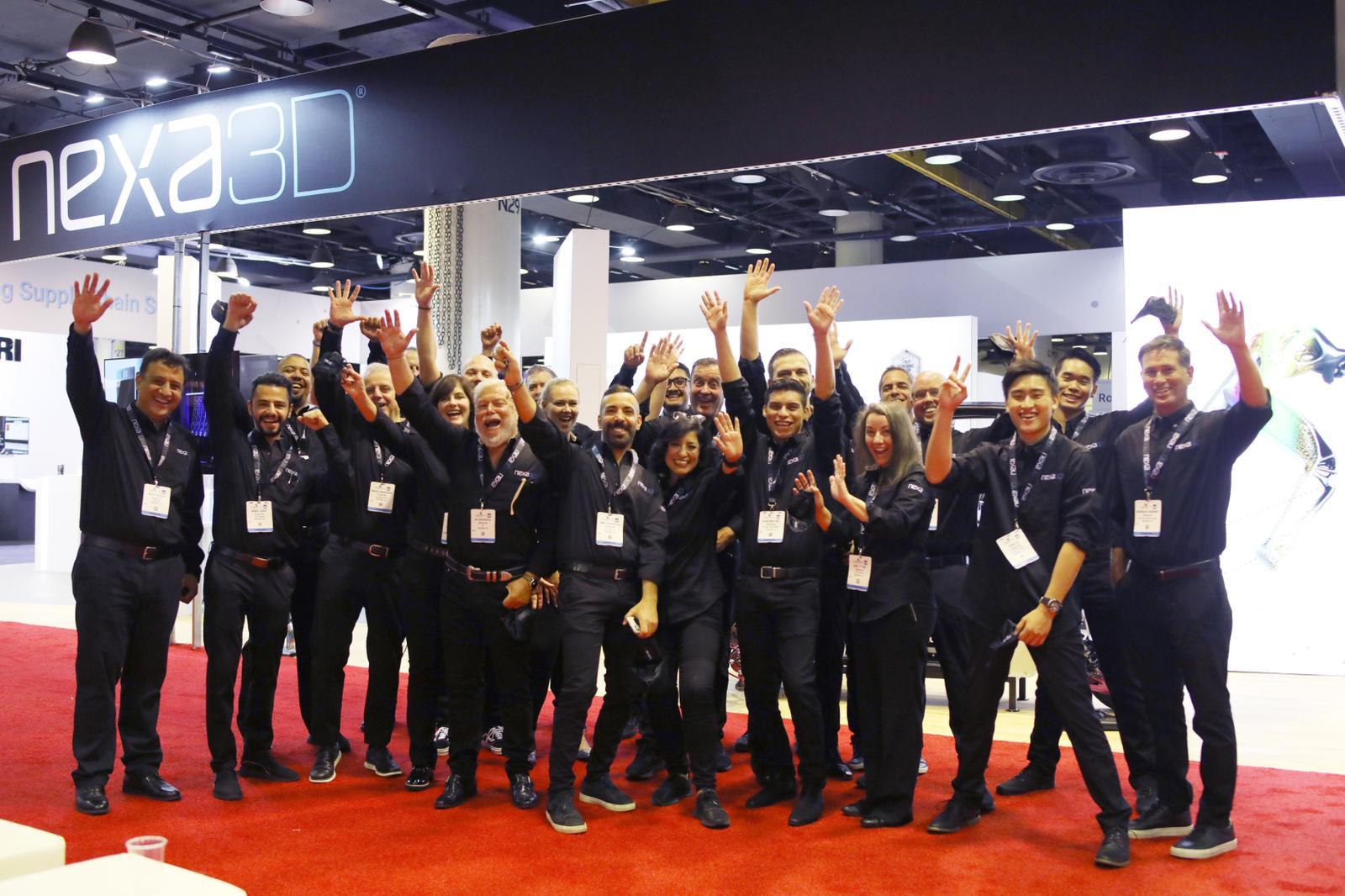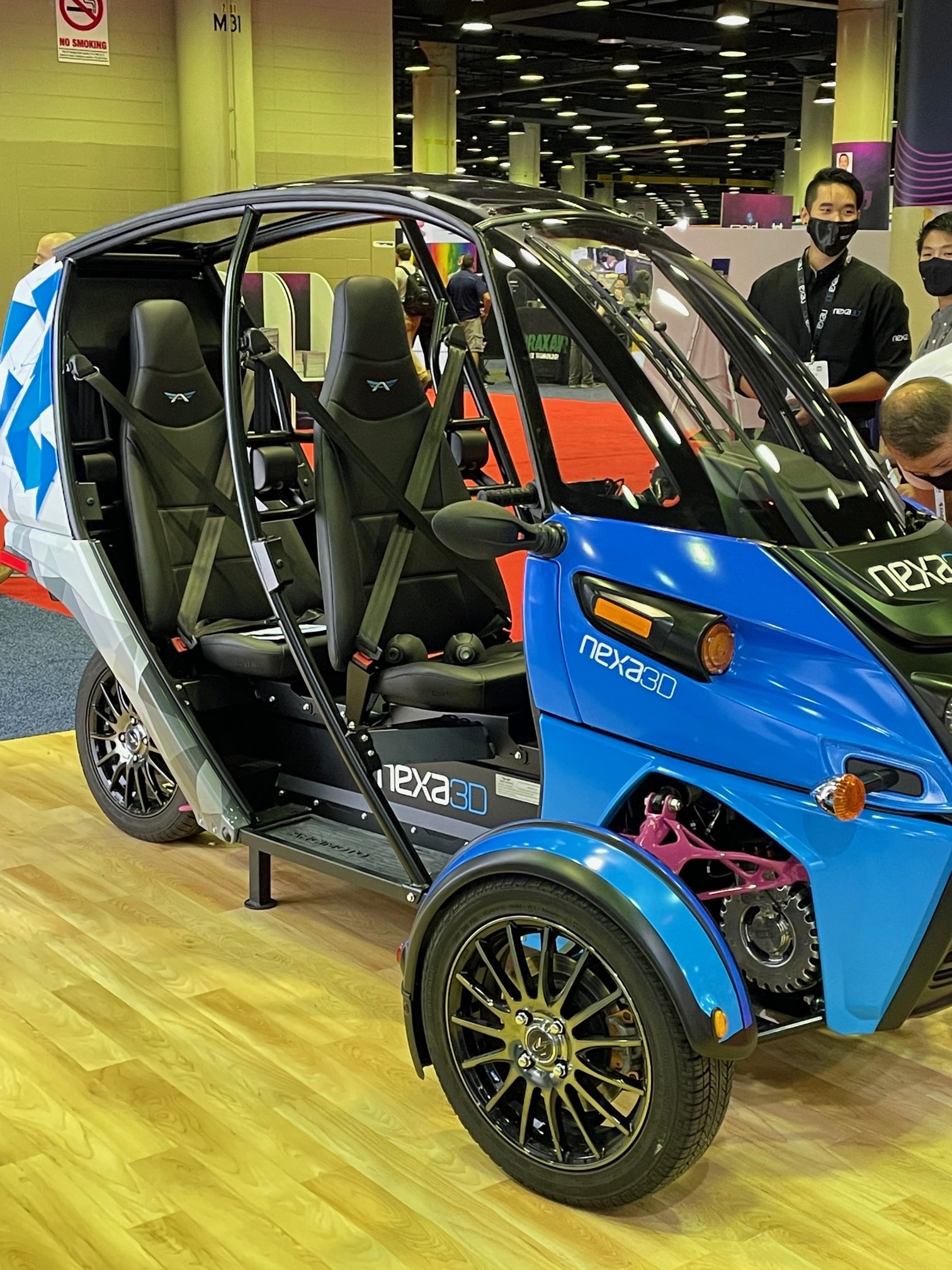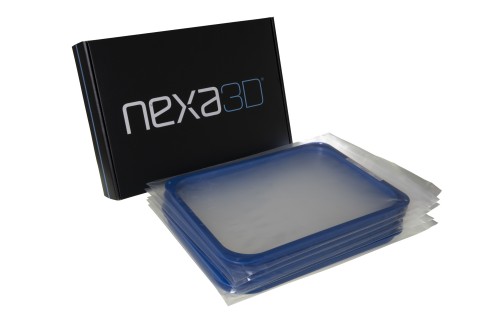During the recent RAPID + TCT 2021 event, ultrafast polymer 3D printer maker Nexa3D showcased its end-to-end 3D printing validated workflow for the first time. From September 13 through 15, attendees got to experience first-hand the benefits of Nexa3D’s equipment as well as new product launches and partnership announcements at the event held. In addition, Nexa3D Co-Founder and CEO Avi Reichental discussed with 3DPrint.com the demand for 3D printing in several industries, the company’s plans for the future, and the heightened interest from investors in the additive manufacturing (AM) industry.

Avi Reichental with the Nexa3D team during the first day of RAPID + TCT 2021. Image courtesy of Nexa3D via Twitter.
Nexa3D started operations in the US in 2014, after Reichental and co-founders Andrea Denaro, Gianni Zitelli, and Luciano Tringali decided to focus on building super-fast 3D printing technology that could unlock the full potential of additively manufactured polymers for volume production. Leveraging speed and scale as two of the building blocks of Nexa3D’s success, the company has raised $95 million and is one of 3DPrint.com’s potential businesses in line to become 3D printing unicorns, unless they decide to go the SPAC route, like many competing firms these days. The business had enormous capital efficiency throughout every phase of its growth over the past five years, and the latest $64 million round gives it greater financial strength and flexibility.
“There has never been a more exciting time to be in AM (except maybe next year), so it shouldn’t be surprising that so much capital is coming into the space. With more capital available for both earlier stage companies and greater access to public equity by the newly minted class of publicly traded companies, I certainly anticipate more unicorns in the coming periods as well as heightened paces and urgency to consolidate parts of the market,” described Reichental.
At the RAPID + TCT 2021 event in McCormick Place, Chicago, Nexa3D announced the immediate commercialization of its next-generation Everlast-2 Membrane for use with Nexa3D NXE series printers, and attendees got to witness it in action. The new product extends the useful life of Nexa3D liquid interface technology membranes exponentially, providing less downtime for membrane changes and much longer continuous runs in demanding series-production operations.
Also showcased at the Nexa3D stand was the SKOP stethoscope. Additively manufactured in partnership with polymers leader Henkel and French medical device company WeMed, the product is described as the world’s first connected stethoscope entirely 3D printed at scale with production volumes that could exceed 100,000 units per year. Nexa3D also announced the development of turnkey AM production systems with Henkel to accelerate adoption in targeted end-use markets. Additionally, the duo opened a full-scale AM customer center called NEXTFACTORY in Ventura, California.

WeMed SKOP is the world’s first connected stethoscope to be additively manufactured by Nexa3D. Image courtesy of Nexa3D.
Talking about the company’s WeMed SKOP, Reichental said it represents a new class of products developed and optimized fully for additive production, taking full advantage of biomimicry acoustics to get to market quickly and scale without the brittleness, constraints, and complexity of traditional supply chains. The SKOP is a great example of how the healthcare sector is quickly becoming one of the most relevant markets for 3D printing, something Reichental said he envisioned back in 2019. Today, and like many, he believes the coronavirus pandemic continues to act as a catalyst for accelerated adoption.
“Our ability to provide an end-to-end additive production system, coupled with the formulation of custom materials that are color-matched for specific customer requirements, can deliver a comprehensive volume production solution, not just medical devices but also consumer products. So, yes, we see health products as a significant opportunity for Nexa3D, but we equally see lots of other consumer electronic products benefiting a hyper-local resilient supply chain.”

The Nexa3D booth at RAPID + TCT 2021 shows what the company can do for the dental industry. Image courtesy of Sarah Saunders/3DPrint.com
As for Nexa3D’s future in the healthcare and dental industries, he considers both sectors are “truly open-ended verticals for AM in general and Nexa3D in particular.” Reichental commented that the advent of better functional biocompatible materials that Nexa3D can now deliver, coupled with its 20 times greater productivity and lower total cost of ownership (as low as 85% compared to other solutions on the market), makes Nexa3D a very compelling solution for dental labs, aligner manufacturers and healthcare products and devices companies.
Reichental also predicts that surgeries will change in the next few years, as surgeons continue to rely on 3D printed implants, 3D models for successful surgeries, training, and medical device testing.
“There is no question in my mind that the digitization of surgical planning workflows as well as mixed reality and mixed media simulation and the adoption of patient-specific surgical guides will increase and to a large extent follow what we already witnessed in hearing aids and dental restorations where these industries are benefiting from a robust digital thread across their entire workflow.”

Functional parts 3D printed in different materials showcased at Nexa3D’s booth at RAPID + TCT 2021. Image courtesy of Sarah Saunders/3DPrint.com
Considered by many to be a tech visionary, Reichental is also a serial entrepreneur. Aside from his role at Nexa3D, he is also the founder and CEO of XponentialWorks, an advisory, venture investment, and incubation ecosystem company for exponential tech innovation. For 12 years, Reichental also served as the CEO of 3D printing pioneer 3D Systems, is an active inventor with 40 patents, and is part of Singularity University’s core faculty in Santa Clara, California.
When it comes to the disruptive effect of the 3D printing industry, he says several industries are “ripe” to embrace AM and take it to large-scale production. In particular, Reichental is excited about the advances that Nexa3D is making for lightweight transportation, like the Fun Utility Vehicle (FUV) project with Arcimoto, which was showcased at the Nexa3D RAPID + TCT stand. The affordable, ultra-efficient, small-footprint electric vehicle is great for maneuverability and performance, extends the driving range on a single charge, and is good for the environment since Nexa3D managed to put “certain parts on a diet of between 35% and 50% weight reduction,” stated Reichental.
“In the here and now, certainly dental and healthcare rain supreme. However, success stories, like the Arcimoto FUV, shape and inform the future of mobility as well as last-mile transportation harvesting all the benefits of AM. I am equally excited about expanding opportunities in aerospace for similar reasons and the impact on both industries as we help them digitize their supply chain sustainably. Much is also being done in consumer products where I see tremendous opportunities to return to hyper-local manufacturing, that is, more sustainable and cost-effective orders of magnitude.”

The Fun Utility Vehicle (FUV) project by Nexa3D and Arcimoto. Image courtesy of Sarah Saunders/3DPrint.com
At the Nexa3D booth, attendees got to see the company’s end-to-end validated workflow for the first time, following the recent release of the xWASH post-processing system. In addition, visitors learned about the benefits of applying the full range of equipment that makes up Nexa3D’s end-to-end solution for industrial and dental, and health applications. The stand featured the ultrafast NXE400 photo plastic 3D printer and the NXD200 dental 3D printer, alongside post-processing equipment such as the xCURE. With so many announcements this year and a commitment to digitizing the world’s supply chain sustainably, Nexa3D is all about enhancing productivity and performance orders of magnitude, according to its CEO.
“What the industry needs are next-gen functional materials, smart AI-powered digital thread, and automation. The breakthroughs will come from integrated manufacturing systems that can take production speeds and yields beyond traditional manufacturing. The industry is evolving from supply chain-approved plastics and metals to a new generation of performance-optimized materials. The biggest mistake a company seeking to adopt additive production can make is to try and produce the same products they optimized for the past 50 years for the traditional manufacturing process. As we demonstrated recently with both the WeMed SKOP and the Arcimoto FUV, the biggest gain comes from designing for AM products that take advantage of new materials but also of topology optimization, lightweight, and a new design thinking that can be replicated at scale.”
At this rate, by 2030, Reichental predicts that 33% of global manufacturers will have additive production lines on their factory floor. That’s excellent news for the company as it continues to expand its portfolio of ultrafast 3D printing products and seeks out partnerships, mergers, and acquisitions, understanding that the 3D printing ecosystem is built upon collaborative efforts.
Subscribe to Our Email Newsletter
Stay up-to-date on all the latest news from the 3D printing industry and receive information and offers from third party vendors.
You May Also Like
3D Printing Webinar and Event Roundup: April 21, 2024
It’s another busy week of webinars and events, starting with Hannover Messe in Germany and continuing with Metalcasting Congress, Chinaplas, TechBlick’s Innovation Festival, and more. Stratasys continues its advanced training...
3D Printing Webinar and Event Roundup: April 14, 2024
We’re starting off the week’s 3D printing webinars and events at ASTM AMCOE’s 11th Snapshot Workshop and MACH Exhibition. Stratasys continues its advanced training courses, SME is holding a virtual...
Polly the Duck to Receive 3D Printed Bill Prosthetic
In Williamson County, Texas, a story of resilience, innovation, and cross-community effort is unfolding, illustrating the bond between humans and wildlife. All Things Wild, a wildlife rehabilitation center, has been...
3D Printing News Briefs, April 3, 2024: Kickstarter FDM 3D Printer, Artificial Eyes, & More
In 3D Printing News Briefs today, we’re talking about an FDM 3D printer on Kickstarter, advancements in artificial eye creation, and 3D printed solenoids for electromagnets. Then we’ll move on...

































